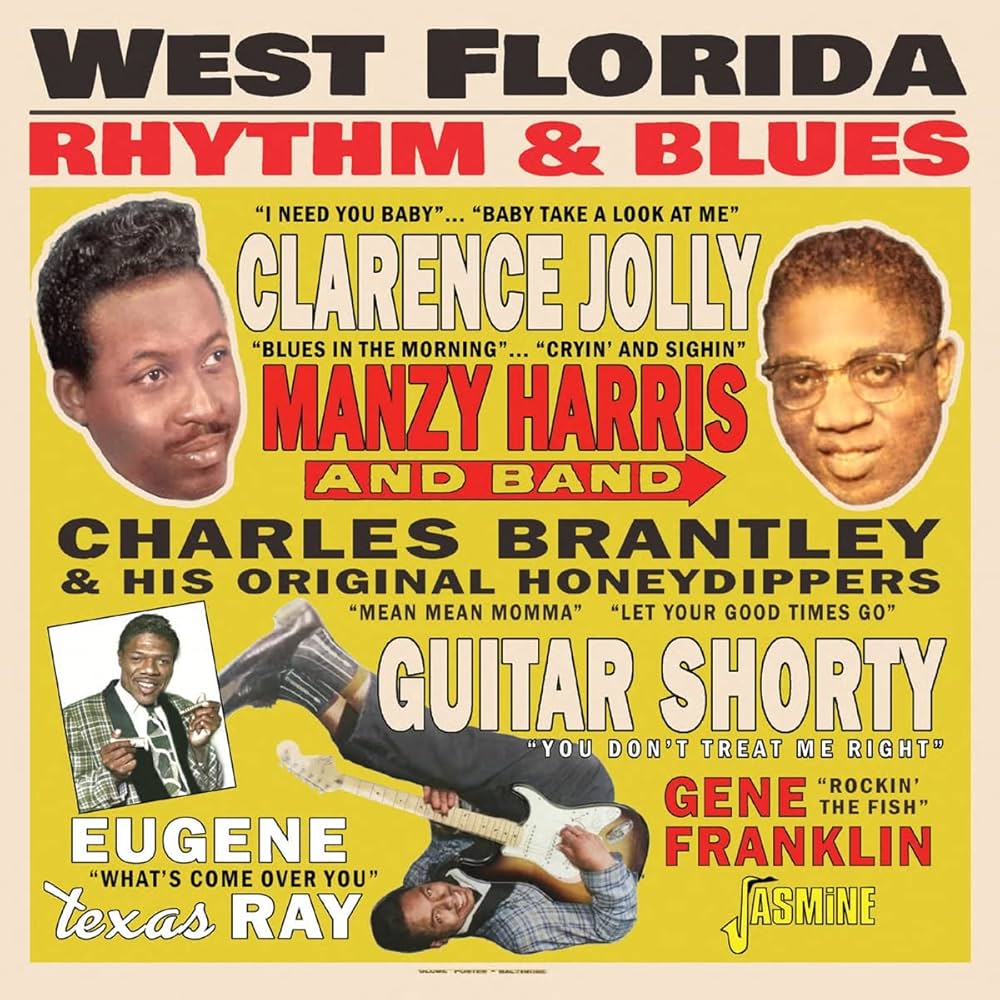Compared to other southern states, Florida isn’t known as a hotbed for blues music. But through the years, there have been small pockets of blues history to celebrate in Florida. Zora Neale Hurston, for example, wrote extensively about the blues in the farmlands of Central Florida in the 1930s. There have also been enclaves of blues recordings in North Florida and South Florida. But of all the Florida regions, Tampa Bay (Tampa and St. Petersburg) had possibly the biggest organic urban blues scene in the state.
Emphasis on had.
Unfortunately, redevelopment, overdevelopment, and the urban renewal movement of the 1960s destroyed many of the spaces and places for blues culture in Tampa Bay. Only very recently has the region started telling stories of these pasts. To help our journey, from the UK comes Jasmine Records’ 2023 release West Florida Rhythm & Blues – a wonderful collection of 1950s Blues and R&B mostly from Tampa Bay.

Let’s take a trip down memory lane and explore West Florida Rhythm & Blues track by track.
The first six songs of the twenty-five-track album are a collection by Charles Brantley, who the CD liner notes says was highly influenced by Louis Jordan. The first two songs, “I Need You Baby” and “You’d Better Change Your Ways” are credited to Brantley’s frequent frontman/singer Clarence Jolly. These songs are very blues in structure and content, but are driven by a piano and horn section and a swinging sound. “I Need You Baby” is upbeat and “You’d Better Change Your Ways” has a slower tempo.
Following the Jolly songs are four songs credited to Brantley. The upbeat but bluesy “Mean Mean Momma” includes a wonderful sax solo, which you don’t hear often in modern blues. “Every Man’s Blues” is one of the more upbeat tunes on the album, definitely danceable by 1950s standards. Brantley’s horn section carries the tunes where the guitar would in other songs in the genre.
After the series of Brantley and Jolly tunes, we have two songs by Manzy Harris and His Band. According to the Tampa Bay Times, Harris was a friend of Ray Charles and often jammed with him in the bars of Tampa’s once-happening Central Avenue. Manzy continues with the blues feel and lyrics, repeating lines and lamenting lost loves. The music has the same feel as Brantley, with the horns soloing over a big band blues beat. Typical of a band that played with Ray Charles, the piano plays a big role in emphasizing the beat, even if it isn’t the legendary pianist.
Track 9 and 10 return to Charles Brantley and his orchestra. These songs were recorded in 1957, six years after the previous set. Although the lyrics are still blues-based, these are less blues songs and more boogie-woogie. Almost like a missing link between blues and rock’n’roll.
Next are two Guitar Shorty songs. Guitar Shorty, born David William Kearney, cut his teeth in Tampa. While playing with a musician named Walter Johnson, about whom little is known (unless it’s the Walter Johnson who played with Tab Smith, etc), Shorty was spotted by blues legend Willie Dixon. Dixon brought Shorty to Chicago and recorded “Irma Lee” and “You Don’t Treat Me Right” on Cobra Records. “Irma Lee” is more guitar-driven than “You Don’t Treat Me Right,” but both show Shorty’s early guitar mastery.
Following Guitar Shorty is yet another Charles Brantley and his Orchestra song, “I Feel So Lonesome,” featuring Charles Jolly, Guitar Shorty, and Willie Dixon on bass. This song, recorded in 1957, has a slow pace and a big band sound to go with its blues lyrics.
Tracks 14 and 15 are two more Clarence Jolly songs recorded in 1960: “Don’t Leave Me” and “Changing Love.” Jolly sounds enthusiastic in “Don’t Leave Me,” a song with an upbeat tempo, a wailing saxophone, and a brief guitar solo. “Don’t Leave Me” is slower and has almost a Chicago-type sound to it with some great piano playing.
Two songs by Texas Ray are next on the album: “What’s Come Over You” and “Mary Ann,” written by Ray Charles. Texas Ray wails unlike anyone else on this album. There is almost a little James Brown to Texas Ray. Compared to the smooth voices on the album, Texas Ray is a bit jarring and grittier, but still good.
After the Charles Brantley Band broke up, several of the members formed The Skyliners. The Skyliners’ “Rock-A-Baby Rock” is track 18 on West Florida Rhythm & Blues. This is definitely more of an early rock tune than R&B or blues. Combined with an awkward baby wail, there isn’t much of a reason for this song to be on the album, except to link it with Brantley’s work.
Gene Franklin and the Spacemen are the final new artists featured on the album, contributing four songs: “Hackensack Blues I,” “Hackensack Blues II,” “Itchin’ and Twistin’,” and “Rockin’ the Fish.” These are Chubby Checker-type dancing rock songs with the last two being instrumentals. Although two are called blues, there aren’t many blues elements here. I wouldn’t even call them R&B. They are early rock’n’roll.
Just for kicks, West Florida Rhythm & Blues ends with three more songs by Charlie Brantley, two with his orchestra and one with his group The Honeydippers. Although they have a different sound, I am not sure why these slow R&B songs aren’t grouped with the earlier Brantley recordings.
Overall, West Florida Rhythm & Blues is a fun and interesting trip through Tampa Bay blues and R&B history. Although many of the places these bands performed are no longer standing, this album gives us insight into the artists and sounds of the day. While Tampa Bay celebrates Ray Charles and gives credit to Guitar Shorty, this collection and the people in it should be more widely known.


